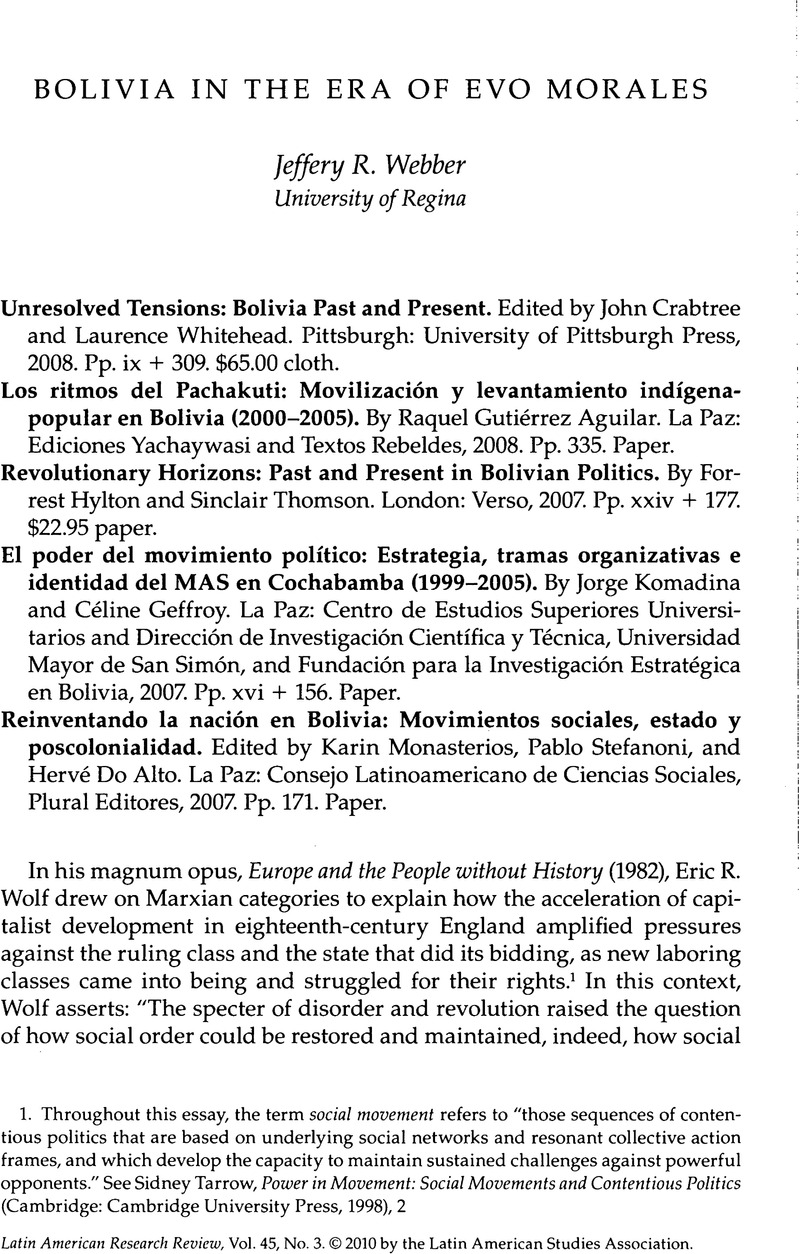Article contents
Bolivia in the Era of Evo Morales
Review products
Published online by Cambridge University Press: 05 September 2022
Abstract

- Type
- Review Essays
- Information
- Copyright
- Copyright © 2010 by the Latin American Studies Association
References
1. Throughout this essay, the term social movement refers to “those sequences of contentious politics that are based on underlying social networks and resonant collective action frames, and which develop the capacity to maintain sustained challenges against powerful opponents.” See Sidney Tarrow, Power in Movement: Social Movements and Contentious Politics (Cambridge: Cambridge University Press, 1998), 2
2. Eric R. Wolf, Europe and the People without History (Berkeley: University of California Press, 1997), 8.
3. Samuel P. Huntington, Political Order in Changing Societies (New Haven, CT: Yale University Press, 1968), 196.
4. See Jeffery R. Webber, Red October: Left-Indigenous Struggles in Modern Bolivia (Leiden: Brill Academic Publishers, 2010).
5. José Luis Roca, Fisonomía del regionalismo boliviano (La Paz: Editorial Los Magos del Libro, 1980).
6. See, among other sources, Mark Weisbrot and Luis Sandoval, The Distribution of Bolivia's Most Important Natural Resources and the Autonomy Conflicts (Washington, D.C.: Center for Economic and Policy Research, 2008).
7. The most important of these works are Pablo Stefanoni and Hervé Do Alto, Evo Morales: De la coca al palacio: Una oportunidad para la izquierda indígena (La Paz: Malatesta, 2006); Shirley Orozco Ramírez, “Historia del Movimiento al Socialismo (MAS): Trayectoria política e ideológica,” Barataria 1, no. 2 (2004): 16–22; Pablo Stefanoni, “MAS-IPSP: La emergencia del nacionalismo plebeya,” Observatorio Social de América Latina 4, no. 12 (2003): 57–68.
8. María Teresa Zegada, Yuri F. Tórrez, and Gloria Cámara, Movimientos sociales en tiempos de poder: Articulaciones y campos de conflicto en el gobierno del MAS (La Paz: Plural Editores, 2008).
9. See Jeffery R. Webber, “From Naked Barbarism to Barbarism with Benefits: Neoliberal Capitalism, Natural Gas Policy and the Evo Morales Government in Bolivia,” in Post-Neoliberalism in the Americas, ed. Laura MacDonald and Arne Ruckert (New York: Palgrave Macmillan, 2009), 105–119.
10. Pablo Stefanoni and Hervé Do Alto, Evo Morales de la coca al Palacio: Una oportunidad para la izquierda indígena (La Paz: Malatesta, 2006).
11. Admirable exceptions include Denise Y. Arnold and Alison Spedding, Mujeres en los movimientos sociales en Bolivia 2000–2003 (La Paz: Centro de Información y Desarrollo de la Mujer and Instituto de Lengua y Cultura Aymara, 2005); Forrest Hylton, Lucila Choque, and Lina Britto, La guerra del gas: Contada desde las mujeres (El Alto: Centro de Promoción de la Mujer Gregoria Apaza, 2005).
- 13
- Cited by




